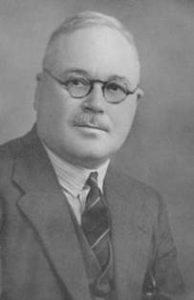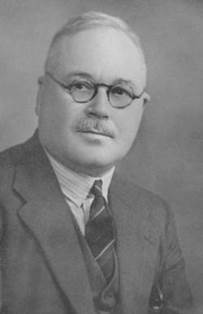(17 August 1889 – 3 September 1958)
The University of North Carolina at Chapel Hill Herbarium (NCU) curates about 80 fungal specimens collected by G. R. Bisby. Bisby frequently used “MAC, Winnipeg, Man.” as a location on his specimen labels. According to Cynthia Dietz, GIS Environmental Studies Librarian at the University of Manitoba, “MAC” refers to the Manitoba Agricultural College. The center of the Manitoba Agricultural College ca. 1930 is now an administration building for the University of Manitoba (49°48’34.36”N, 97° 07’57.77” W).
Other herbaria curating Bisby’s specimens include University of Tennessee, Knoxville (TENN), U.S. National Fungus Collections, USDA-ARS (BPI), University of Michigan (MICH), Cornell University (CUP), Farlow Herbarium of Harvard University (FH), New York Botanical Garden (NY), Oregon State University (OSC), University of Minnesota (MIN), Iowa State University (ISC), Louisiana State University (LSUM), Miami University (MU), Purdue University (PUR, PUL), Royal Ontario Museum (TRTC), State University of New York (SYRF), Swedish Museum of Natural History (S), University of British Columbia (UB), University of California, Berkeley (UC), Florida Museum of Natural History (FLAS), University of Gothenburg (GB), University of Illinois, Champaign-Urbana (ILL), University of Manitoba (WIN), University of Montana (MONTU), University of Wisconsin, Madison (WIS), University of Wyoming (RMS), Museum of Evolution (UPS), and Canadian National Mycological Herbarium – AAFC (DAOM).1
NCU’s mycological collection is cataloged in mycoportal.org
+++++
“Another man at the University of Manitoba who made a major contribution to the mycology of that province was Guy Richards Bisby (1889-1958), a native of South Dakota, USA, where he got his bachelor’s degree from the state college in 1912. He earned an AM degree from Columbia University before attending the University of Minnesota for the Ph.D. that he was awarded in 1918. Bisby did some teaching at Minnesota, and had a period of employment at Purdue University where he worked with J.C. Arthur, North America’s leading authority on the classification of rust fungi, before going to Manitoba to become the first professor of plant pathology in a Canadian university. Except for leave periods, one of which was for nearly a year (1921-22) to study mycology and plant pathology in England, Bisby remained at the University of Manitoba until he resigned in 1937 to accept a position in the Commonwealth Mycological Institute, Kew, England, where he had a distinguished career.
Bisby cooperated with Buller to produce a Preliminary list of Manitoba fungi in 1922. In 1924 he published an account of the fungi he collected north of Lake Winnepeg, and, with plant pathologists I.L. Conners and D.L. Bailey, produced The parasitic fungi found in Manitoba. However, from a mycological standpoint, Bisby is perhaps best remembered for his leadership in the preparation and publication of two books on fungi: The fungi of Manitoba, in cooperation with Buller and veteran mycologist John Dearness in 1929, plus its two supplements, the second of which contained 289 additions and was included in the thirteenth annual report of the Canadian Plant Disease Survey in 1934; and their extension, The fungi of Manitoba and Saskatchewan in 1938, for which he had the additional assistance of W. P. Fraser and R.C. Russell. Several thousand fungi collected by Bisby, including a few by Buller and others mentioned in those books, were placed in the herbarium of the University of Manitoba, from which they were eventually transferred to DAOM, in Ottawa. “ Estey, Ralph H. (1994) Essays on the early history of plant pathology and mycology in Canada. McGill-Queens University Press. p. 276-277.

“His skill as a compiler was in frequent demand at the Commonwealth Mycological Institute where he produced the Institute’s first list of tropical plant diseases and for more than a decade supervised the production of the Index of Fungi. These tasks were mostly undertaken with the minimum of clerical assistance and were only accomplished by maintaining a very regular pattern of work – an early start, a midday break for, weather permitting, and hour’s gardening, and as a rule no mycology in the evening but early to bed… Dr. Bisby was of a retiring disposition, he was rarely seen at meetings and never, I believe, attended an international congress. He had, however, many friends and correspondents by whom he will be long remembered on both sides of the Atlantic.” Ainsworth, G. C. (1959) Guy Richard Bisby. Taxon 8(1): 2.
PUBLICATIONS 2:
Bisby, G. R. (1914) Some observations of the formation of the Capillitium and the development of Physarella mirabilis Peck and Stemonitis fusca Roth. American J. of Botany 1(6): 274-288.
Bisby, G. R. (1916) The Uredinales found upon the Onagraceae. American J. of Botany 3(10): 527-561.
Arthur, J. C. and G. R. Bisby (1918) An annotated translation of the part of Schweinitz’s two papers giving the rusts of North America. Proc. Of the Am. Philosophical Soc. 57(3): 173-292.
Bisby, G. R. (1920) Short cycle Uromyces of North America. Botanical Gazette 69(3): 193-217.
Bisby, G. R. (1923) The literature on the classfication of the Hysteriales. Trans. Of the British Mycological Society 8: 176-189.
Bisby, G. R. (1924) Fungi from central Manitoba. Mycologia 16(3): 122-129.
Bisby, G. R. (1925) Zonation in cultures of Fusarium discolor sulphureum. Mycologia 17(3): 89-97.
Bisby, G. R. (1925) The Barro Colorado Island laboratory. Science, New Series, 62(1596): 111.
Bisby, G. R., A. H. R. Buller and J. Dearness (1929) Fungi of Manitoba. London, New York, Toronto: Longmans, Green & Company.
Bisby, G. R. (1932) Type specimens of certain Hystriales. Mycologia 24(3): 304-329.
Bisby, G. R. (1933) The distribution of fungi as compared with that of phanerogams. American J. of Botany 20(4): 246-254.
Bisby, G. R. (1935) Are living spores to be found over the ocean? Mycologia 27(1): 84-85.
Bisby, G. R. and E. W. Mason (1940) List of Pyrenomycetes recorded for Britain. Trans. of the British Mycological Society 24: 127-243.
Bisby, G. R. (1941) British species of Hysterium, Gloniopsis, Dichaena and Mytilidion. Trans. Of the British Mycological Society 25: 127-140.
Bisby, G. R., E. M. Mason and E. M. Wakefield (1942) A note on nomenclature. Mycologia 34(2): 214-217.
Bisby, G. R. (1943) Geographical distribution of fungi. Botanical Review 9(7): 466-482.
Bisby, G. R. (1943) Stachybotrys. Trans. Of the British Mycological Society 26: 133-143.
Ainsworth, G. C. and G. R. Bisby (1943) Dictionary of the Fungi. viii + 359pp., 138 figs. United Kingdom: Kew, Imperial Mycological Institute.
Bisby, G. R. (1943) The numbers of fungi. Trans. of the British Mycological Society 26: 16-19.
Bisby, G. R. (1944) Nomenclature of fungi. Mycologia 36(3): 279-285.
Bisby, G. R. (1944) The British Hysteriales, II. Trans. of the British Mycological Society 27: 20-28.
Bisby, G. R. (1945) An introduction to the taxonomy and nomenclature of fungi. vii + 117 pp. United Kingdom: Kew, Imperial Mycological Institute.
Bisby, G. R. (1945) What are mycologists doing about nomenclature? Annals of Applied Biology 32: 183.
Bisby, G. R. (1945) Stachybotrys and Memnoniella. Trans. of the British Mycological Society 38: 11-12.
Ainsworth, G. C. and G. R. Bisby (1945) Dictionary of the Fungi. Edition 2: 431 pp. United Kingdom: Kew, Imperial Mycological Institute.
Seaver, Fred J. and G. R. Bisby (1945) Arthur Henry Reginald Buller. Mycologia 37(3): 275-277.
Bisby, G. R. (1949) Generic names of fungi proposed for rejection. Commonwealth Mycological Institute Mimeographed Publications 6: 1-59.
Bisby, G. R. and M. B. Ellis (1949) Stachybotrys dichroa Grove. Trans. of the British Mycological Society 32: 158-161.
Ainsworth, G. C. and G. R. Bisby (1950) Dictionary of the Fungi. Edition 3: 447 pp. United Kingdom: Kew, Commonwealth Mycological Institute.
Petch, T. and G. R. Bisby (1950) The fungi of Ceylon. Peradeniya Manual 6. [?incomplete citation?]
Bisby, G. R. (1952) The name Oidium. Trans. of the British Mycological Society 35: 236-237.
Bisby, G. R. and R. W. G. Dennis (1952) Notes on British Hysteriales. Trans. of the British Mycological Society 35: 304-307.
Bisby, G. R. and M. B. Ellis (1952) Lophium elatum Grev. Trans. of the British Mycological Society 35: 299-303.
Bisby, G. R. and S. J. Hughes (1952) Summary of the British Hysteriales. Trans. of the British Mycological Society 35: 308-314.
Bisby, G. R. and P.O. Wiehe (1953) The rusts of Nyasaland. Mycological Papers 54. [?inaccurate citation?]
Dennis, R. W. G., E. M. Wakefield and G. R. Bisby (1954) The nomenclature of Armillaria, Hypholoma and Entoloma. Trans. of the British Mycological Society 37(1): 33-37.
Ainsworth, G. C. and G. R. Bisby (1954) Dictionary of the Fungi. Edition 4: 475 pp. United Kingdom: Kew, Commonwealth Mycological Institute.
Wilson, M. and G. R. Bisby (1954) List of British Uredinales. Trans. of the British Mycological Society 37(1): 61-86.
Bisby, G. R. and C. Booth (1955) On Glonium amplum. Naturalist 1955: 163-164.
Butler, E. J. and G. R. Bisby (1960) The fungi of India. New Delhi, India: Indian Council of Agricultural Research.
SOURCES:
- MyCoPortal . 2022. http://www.mycoportal.org/portal/index.php. Accessed on May 28.
- Partial publications list http://www.cybertruffle.org.uk/cgi-bin/bibquery.pl?author=bisby,%20g.r.
- Photo of Bisby http://www.cybertruffle.org.uk/pics/0001911b.jpg
